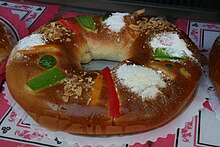The Magi, also referred to as the (Three) Wise Men, (Three) Kings, or Kings from the East, were a group of distinguished foreigners who visited Jesus after his birth, bearing gifts of gold, frankincense and myrrh. They are regular figures in traditional accounts of the nativity celebrations of Christmas and are an important part of the Christian tradition.
Western Christianity celebrates the Magi on the day of Epiphany, January 6, the day immediately following the twelve days of Christmas, particularly in the Spanish-speaking parts of the world. In these areas the Three Kings ("los Reyes Magos de Oriente", also "Los Tres Reyes Magos" and "Los Reyes Magos") receive letters from children and magically bring them gifts on the night before Epiphany. In Spain, each one of the Magi is supposed to represent one different continent, Europe (Melchior), Asia (Caspar) and Africa (Balthasar). According to the tradition, the Magi come from the Orient on their camels to visit the houses of all the children; much like Santa Claus with his reindeer, they visit everyone in one night. In some areas, children prepare a drink for each of the Magi. It is also traditional to prepare food and drink for the camels, because this is the only night of the year when they eat.
In Spain, Argentina, México and Uruguay there is a long tradition for having the children receive their Christmas presents by the three "Reyes Magos" (the figure of Santa Claus only appeared in recent years) on the night of January 5 (Epiphany Eve). Almost every Spanish city or town organises "cabalgatas" in the evening, in which the kings and their servants parade and throw sweets to the children (and parents) in attendance.
KING'S CAKE
"Roscón de reyes" or "rosca de reyes" (kings' ring) is a Spanish and Spanish American king's cake pastry traditionally eaten to celebrate Epiphany. Although the name indicates that it should be round, the “rosca de reyes” generally has an oval shape due to the need to make cakes larger than 30cm across for larger parties. Recipes vary from country to country. For decoration, fig fruit, quinces, cherries or dried and candied fruits are used. It is traditionally eaten on January 6, during the celebration of the "Día de Reyes" (literally "Kings' Day"), which commemorates the arrival of the three Magi. In Spain "roscones" bought in cake shops hide in their interior a figure - either of Jesus or others like little toys for kids and a dry faba bean. Whoever finds the figure is crowned and becomes the "king" or "queen" of the banquet, whereas whoever finds the bean has to pay next year's roscón.

No comments:
Post a Comment